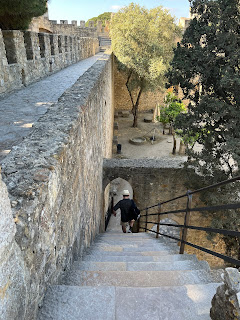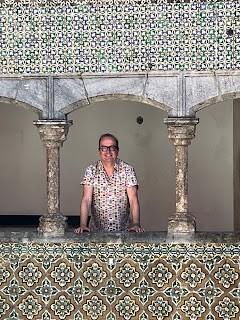Castelo de Sao Jorge (St. George's castle) is a Moorish castle perched high above Lisbon. It was built sometime in the 900s AD, on top of a ancient fortification from the 1st century AD. The onsite museum points to human habitation on this site since the 8th century BC. There have been people living with this vantage point for a very, very long time.
the first king of Portugal took it over in the 12th century and it flourished for several hundred years. It was here that King Manuel received Vasco da Gama after his amazing sea voyage to India. Maybe that's when and how the peacocks arrived. They seem quite happy, although their call is a little plaintiff, like they are still dreaming of home.
Another Moorish Castle awaited us in Sintra, a town 30 minutes away by train. Scrambling over the walls and towers defied vertigo.
We walked down to that castle from the Pena Palace, incredibly perched even higher above the Morrish Castle. We spent two hours walking through the extensive gardens and didn't see half of them. Our garden ramble was a nice way to kill time until our timed ticket allowed us into the Palace. It is one popular place.
It is also a bit bizarre. Built by a German prince who married a Portuguese Queen and, when she died, married a Swiss and American singer, it is an architectural mashup of Moorish, Manueline and Renaissance influences, built around and over a ruined medieval monastery, in the 19th century is romanticism to an extreme.
We took the local bus up but hiked down, a feat that earned a "you're brave" from a ticket seller in town, but it really wasn't that big a deal. Steep yes, and if you didn't have good knees it would have been a difficult 45 minutes, but thankfully our knees are even stronger than normal after two weeks keeping us stable on the high seas.
Down in the town of Sintra one could find another palace, the National Palace , known for its two white cones, which were the innovative and effective chimneys of its vast kitchen. Another place not known for its shy and retiring decoration, it is the best preserved medieval royal home in the country, and yet another UNESCO world heritage site (the whole of Sintra seems to be one big UNESCO locale).
 |
| the swan room, after the princess's favourite animal |
 |
the magpie room, where the king's motto
"for good" is on every magpie's lips (beak?) |
 |
| heraldic throne room |
 |
| tilework - note the corn, a symbol of the Americas |
 |
| one of the two cones seen from the outside |
 |
| looking up from where we walked |
Portuguese museums seem to be located in old religious buildings and the National Tile Museum is another one, this time in a 16th century convent that already held extraordinary tiles, so it was a natural to just add to the collection. The skill of the craft evolved from ancient times, with geometric design elements originally influenced by the Moors (the Portuguese word for tile - azulejo - comes from the Arab word azul), then by the European Renaissance with flora and fauna added, then by China which turned everything blue and white - the heyday of Portuguese ceramic tile and to this day predominant.
 |
| very early tiles, 14th century |
 |
| painted tiles, 15th century |
 |
| an entire wall of tile |
 |
| church altar in tile, 16th century |
 |
| tile in rococco chuch |
 |
| tile storage and repair |
 |
| 18th century |
 |
| 19th century |
 |
| early 20th century |
 |
| even the cafe has tile from an old shop |
 |
| a huge wall of tile depicting the Lisbon pre-1755 earthquake |














































No comments:
Post a Comment